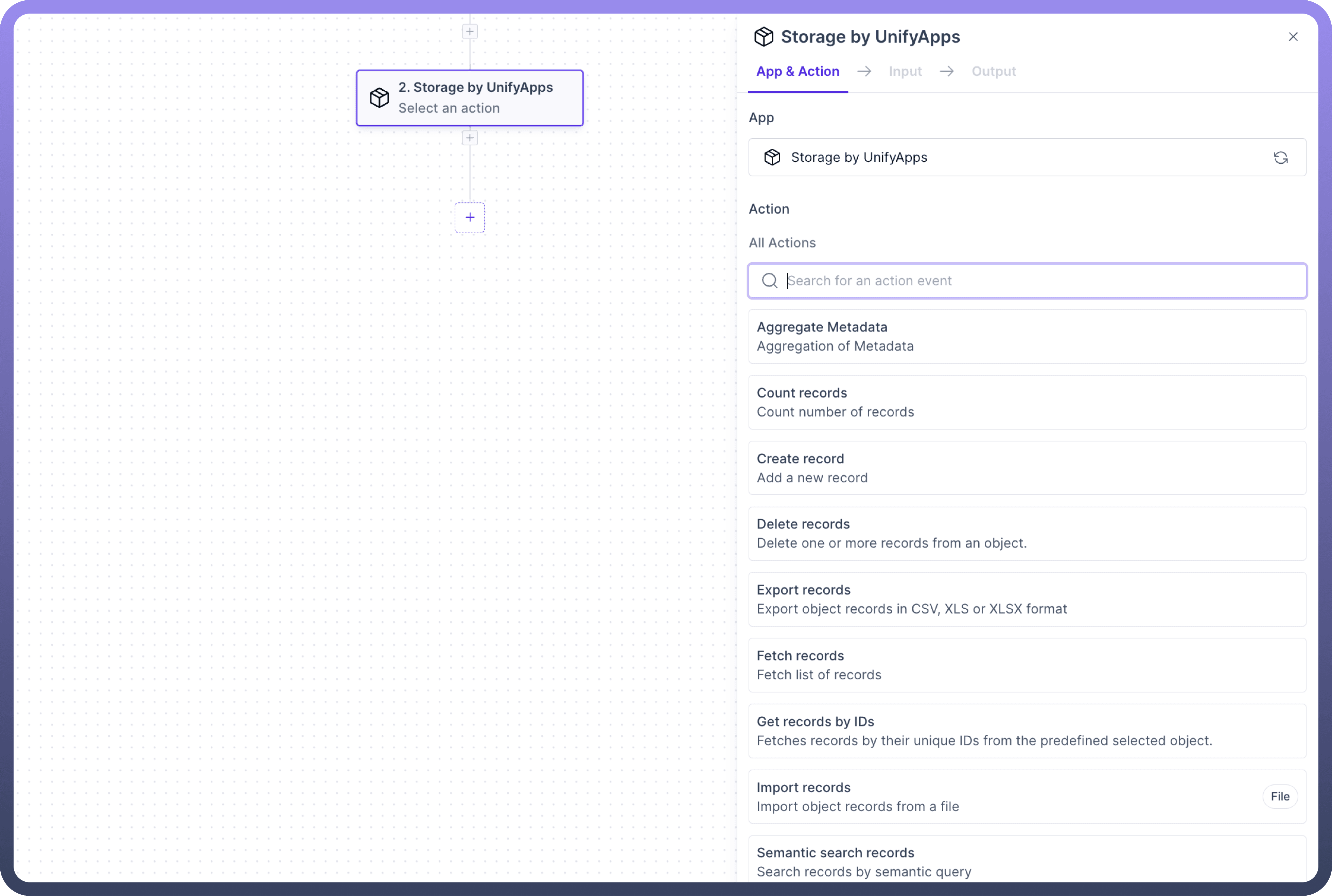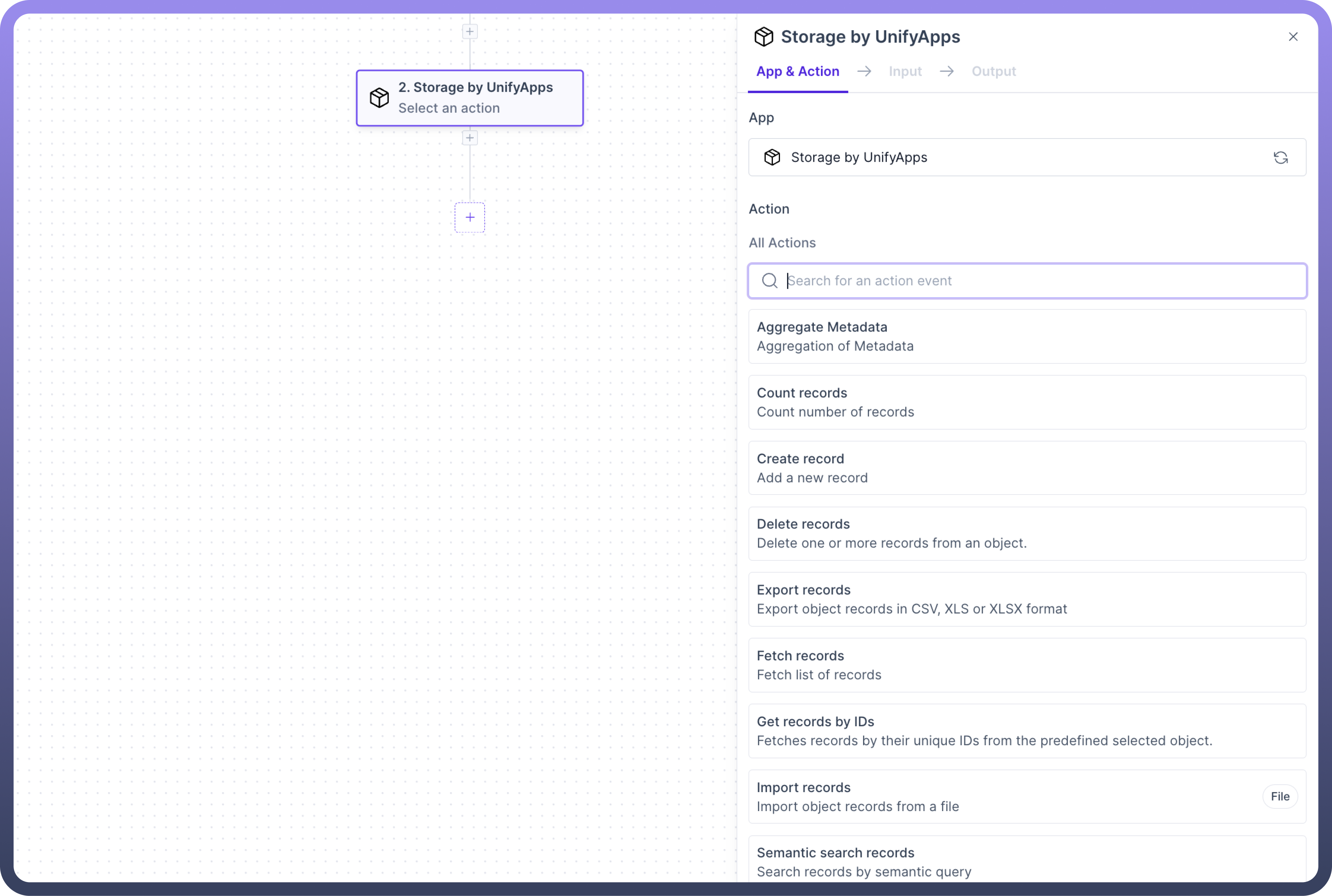Overview
Storage by UnifyApps is a key feature of the UnifyApps Automation Builder, offering robust data management directly within your automations.
It allows users to easily perform a variety of data operations, including creating, reading, updating, and deleting records, as well as more advanced tasks like semantic search and metadata aggregation.


Key Features
Create,
read,update, anddeleterecords.Exportandimportrecords in various formats.Aggregatemetadata for advanced analysis.Performsemantic searches on stored data.Sharerecords with specific users or teams.Countandfetchrecords based on various criteria.
Detailed Breakdown
Aggregate Metadata
The "Aggregate Metadata" action allows you to perform data analysis and summarization on your stored records. This can be useful for generating reports, gaining insights, or preparing data for further processing.
Count Records
Use the "Count records" action to get the total number of records in your storage. This is essential for
reporting,pagination, orconditional logicin your automations.
Create Record
The "Create record" action enables you to add new data to your storage, which is fundamental for capturing information within your automation processes.
Delete Records
With the "Delete records" action, you can remove one or more records from an object in your storage, facilitating data cleanup and management.
Export Records
The "Export records" feature allows you to extract data from your storage in
CSV,XLS, orXLSXformats. This is crucial for data portability, reporting, and integration with other systems.
Fetch Records
Use the "Fetch records" action to retrieve a list of records from your storage, bringing existing data into your automation for processing or decision-making.
Get Records by IDs
The "Get records by IDs" action fetches specific records using their unique identifiers from a predefined selected object, allowing for precise data retrieval.
Import Records
With the "Import records" action, you can bulk add data to your storage from external files, streamlining the process of populating your database or updating large datasets.
Semantic Search Records
The "Semantic search records" feature enables you to search through your data using natural language queries, providing more intuitive and flexible data retrieval options.
Share Records
The "Share records" action allows you to grant access to specific records for particular users or teams, enhancing collaboration and data security within your organization.
Update Record by ID
This action lets you modify an existing record or create a new one if the specified ID doesn't exist, providing flexibility in managing individual data entries.
Update Records by Query
The "Update records by query" action allows you to modify multiple records that match specific criteria, enabling efficient batch updates or data transformations.
Use Cases
Advanced Customer Relationship Management
Scenario: A sales team needs to manage customer data, interactions, and generate reports.
Solution: Utilize create and update actions for maintaining customer records, semantic search for quick information retrieval, and export features for generating reports.
Collaborative Project Management
Scenario: A project team needs to share and update task information across departments.
Solution: Use the create record action for new tasks, share records feature to control access, and update by query for batch status changes
Data-Driven Decision Making
Scenario: Executives need up-to-date aggregated data for strategic planning.
Solution: Implement automations using aggregate metadata and semantic search to compile and analyze relevant data points quickly.
Automated Data Cleansing
Scenario: An organization needs to maintain data quality across large datasets.
Solution: Create automations that use fetch records and update by query actions to identify and correct data inconsistencies periodically.
Dynamic Content Management
Scenario: A website needs to update content based on user interactions and external data sources.
Solution: Use import records to bring in new content, semantic search to categorize it, and update records to refresh displayed information dynamically.